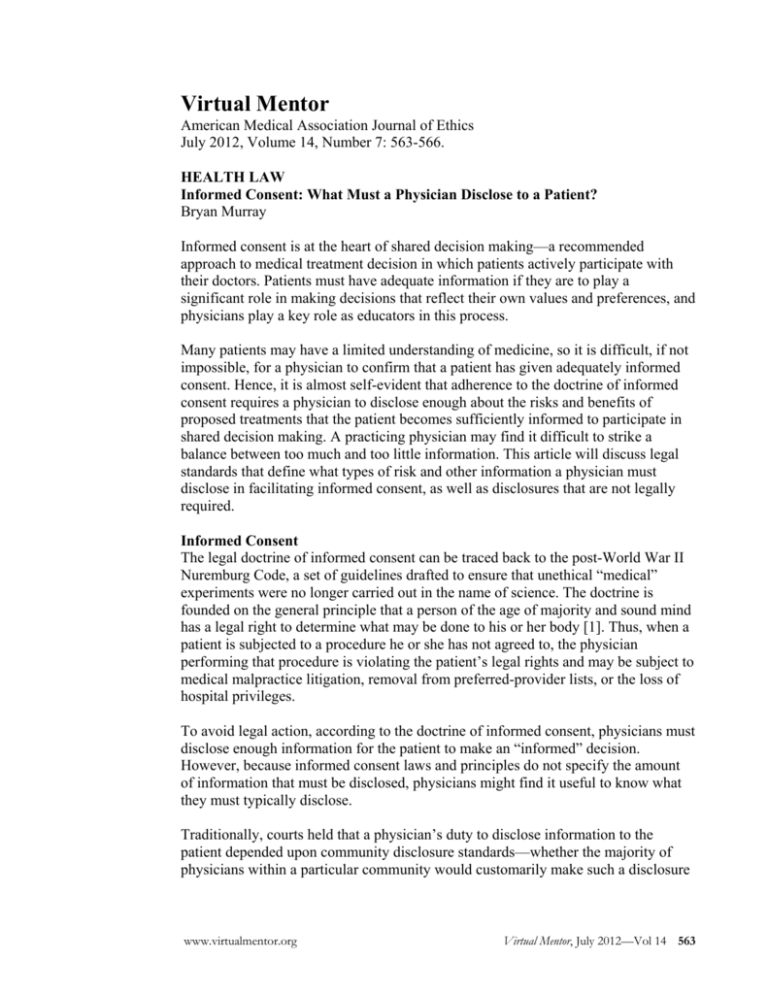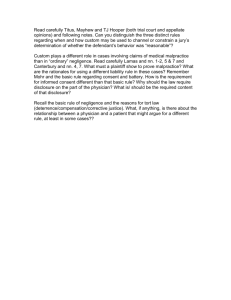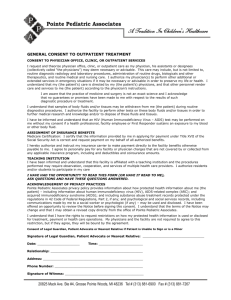
Virtual Mentor
American Medical Association Journal of Ethics
July 2012, Volume 14, Number 7: 563-566.
HEALTH LAW
Informed Consent: What Must a Physician Disclose to a Patient?
Bryan Murray
Informed consent is at the heart of shared decision making—a recommended
approach to medical treatment decision in which patients actively participate with
their doctors. Patients must have adequate information if they are to play a
significant role in making decisions that reflect their own values and preferences, and
physicians play a key role as educators in this process.
Many patients may have a limited understanding of medicine, so it is difficult, if not
impossible, for a physician to confirm that a patient has given adequately informed
consent. Hence, it is almost self-evident that adherence to the doctrine of informed
consent requires a physician to disclose enough about the risks and benefits of
proposed treatments that the patient becomes sufficiently informed to participate in
shared decision making. A practicing physician may find it difficult to strike a
balance between too much and too little information. This article will discuss legal
standards that define what types of risk and other information a physician must
disclose in facilitating informed consent, as well as disclosures that are not legally
required.
Informed Consent
The legal doctrine of informed consent can be traced back to the post-World War II
Nuremburg Code, a set of guidelines drafted to ensure that unethical “medical”
experiments were no longer carried out in the name of science. The doctrine is
founded on the general principle that a person of the age of majority and sound mind
has a legal right to determine what may be done to his or her body [1]. Thus, when a
patient is subjected to a procedure he or she has not agreed to, the physician
performing that procedure is violating the patient’s legal rights and may be subject to
medical malpractice litigation, removal from preferred-provider lists, or the loss of
hospital privileges.
To avoid legal action, according to the doctrine of informed consent, physicians must
disclose enough information for the patient to make an “informed” decision.
However, because informed consent laws and principles do not specify the amount
of information that must be disclosed, physicians might find it useful to know what
they must typically disclose.
Traditionally, courts held that a physician’s duty to disclose information to the
patient depended upon community disclosure standards—whether the majority of
physicians within a particular community would customarily make such a disclosure
www.virtualmentor.org
Virtual Mentor, July 2012—Vol 14 563
[2]. More recently they have acknowledged problems with the community disclosure
standard, chiefly that it creates an incentive for physicians to protect themselves by
collectively limiting the standard disclosures, which is not in patients’ best interests.
In effort to address this problem, the D.C. Circuit Court of Appeals dramatically
altered the physician’s duty to disclose in the seminal case Canterbury v. Spence [3].
In Canterbury, a young man was advised by his physician to undergo a laminectomy
in an effort to alleviate back pain. The physician, aware that 1 percent of
laminectomies resulted in paralysis, did not advise the patient of the risk because he
believed this might cause the patient to reject the useful treatment. Following the
procedure, the patient fell from his hospital bed and was paralyzed. It remained
uncertain whether the laminectomy procedure or the patient’s fall caused the
paralysis.
The patient sued, alleging that the physician failed to inform him of the risks
associated with the procedure. The court held that “the standard measuring
[physician] performance…is conduct which is reasonable under the circumstances”
[3]. In other words, the court held that, instead of adhering to the community
disclosure standard, physicians are now required to disclose information if it is
reasonable to do so. Essentially, to establish true informed consent, a physician is
now required to disclose all risks that might affect a patient’s treatment decisions.
In Canterbury, the decision outlined key pieces of information that a physician must
disclose:
(1) condition being treated; (2) nature and character of the proposed
treatment or surgical procedure; (3) anticipated results; (4) recognized
possible alternative forms of treatment; and (5) recognized serious
possible risks, complications, and anticipated benefits involved in the
treatment or surgical procedure, as well as the recognized possible
alternative forms of treatment, including non-treatment [4, 5].
In two informed consent cases following Canterbury, physicians have also been
required to disclose (1) personal or economic interests that may influence their
judgment (Gates v. Jenson) [6] and (2) all diagnostic tests that may rule out a
possible condition (Jandre v. Physicians Insurance Co of Wisconsin) [7]. In Arato v.
Avedon, however, physicians were not required to disclose particular statistical life
expectancy rates to a patient suffering from pancreatic cancer, mainly on the grounds
that statistics do not usefully relate to an individual’s future [8].
The decision in Nixdorf v. Hicken stipulated that physicians must also disclose
information that a reasonable person in the patient’s position would find important
[9]. In this case, a doctor left a surgical needle in his patient and was held to have a
duty to disclose any information pertinent to the patient’s treatment, including the
patient’s physical condition following treatment [9].
564 Virtual Mentor, July 2012—Vol 14
www.virtualmentor.org
Similarly, a physician must also explain any benefits or risks that may be significant
to the particular patient. For example, any risk of injury to a patient’s hand is
especially important to a concert violinist or professional baseball pitcher. In the
briefest terms, a physician is required to provide general information about a
proposed diagnosis or treatment and more personalized information about how the
treatment might reasonably affect the particular patient.
Truly informed consent may also require disclosure of potential risks associated with
not seeking treatment. In the California case Truman v. Thomas, in which a woman
had refused a pap smear, the court held that a physician had a duty to disclose to her
the possibility that precancerous cells might develop, uncaught, into cervical cancer
if she declined to undergo the procedure [10].
Exceptions
While a physician is required to disclose all reasonable information, he or she is not
required to disclose a risk that is not inherent in proper performance of the
procedure—a risk, in other words, that would result only from the procedure’s being
performed incorrectly [11, 12].
The courts have noted two additional exceptions to the requirement that physicians
elicit and document informed consent. The first applies when both (1) the patient is
unconscious or otherwise incapable of consenting and (2) the benefit of treating the
patient outweighs any potential harm of the treatment. Under these circumstances,
the physician is not required to obtain informed consent before treating, but must do
so as soon as it is medically possible [13, 14].
The second exception applies when disclosing medical information would pose a
threat to the patient. If, for example, a patient has become so emotionally distraught
that he or she would become incapable of making a rational decision, courts
generally do not require disclosure [15]. If disclosure is likely to cause psychological
harm to the patient, a physician does not have a duty
to disclose [16]. However, a physician cannot use the exception to withhold
information merely because he or she thinks the information may cause the patient to
refuse a specific treatment. In other words, a physician must disclose information
that a reasonable person would want to have for decision making, even though that
information may cause the patient to refuse treatment that the physician believes is in
the patient's best interest.
In most states, physicians are not required to disclose specific information about
themselves [18]. In Johnson v. Kokemoor, however, the court held that a physician
may have a legal duty to disclose his or her level of experience with a given
technique when a reasonable person would expect to be told this information. The
case arose after a patient suffered complications from an aneurysm clip procedure
performed by a physician whose lack of experience she was unaware of. The
experience of the physician was viewed as a piece of information that was material
to an informed decision about the procedure [19].
www.virtualmentor.org
Virtual Mentor, July 2012—Vol 14 565
Given that requirements for informed consent are relatively vague and undefined and
the exceptions are few, it is in the physician’s best interest to inform patients
thoroughly about proposed treatment options, ascertain that they understand their
choices, and secure their consent. Doing so will help provide quality patient care and
avoid exposure to legal action.
References
1. Schloendorff v Society of New York Hospital, 211 NY 125, 105 NE 92 (Ny Ct
App 1914).
2. DiFilippo v Preston, 53 Del 539, 173 A2d 333 (1961).
3. Canterbury v Spence, 464 F2d 772 (DC Cir 1972).
4. Barcai v Betwee, 50 P3d 946 (Haw 2002).
5. Gates v Jenson, 595 P2d 919 (Wash 1979).
6. Moore v Regents of University of California, 51 Cal3d 120, 793 P2d 479
(1990).
7. Jandre v Physicians Insurance Co of Wisconsin, 330 Wis 2d 50, 792 NW2d
558 (Wis Ct App 2010).
8. Arato v Avedon, 5 Cal 4th 1172, 858 P2d 598 (1993).
9. Nixdorf v Hicken, 612 P2d 348 (Utah 1980).
10. Truman v Thomas, 27 Cal 3d, 611 P2d 902 (1980).
11. Mallett v Pirkey, 171 Colo 271, 466 P2d 466 (1970).
12. Gilmartin v Weinreb, 324 NJ Super 367, 735 A2d 620 (NJ App Div 1999).
13. Dunham v Wright, 423 F2d 940 (3rd Cir 1970).
14. Stewart-Graves v Vaughn, 162 Wash 2d 115, 170 P3d 1151 (2007).
15. Salgo v Leland Stanford Jr Univ Bd of Trustees, 154 Cal App 2d 560, 317
P2d 170 (Cal Ct App 1957).
16. Cornfeldt v Tongen, 262 NW2d 684 (Minn 1977).
17. Carr v Strode, 79 Hawai’i 475, 904 P2d 489 (1995).
18. Menikoff J. Law and Bioethics: An Introduction. Washington, DC:
Georgetown University Press; 2002.
19. Johnson v Kokemoor, 545 NW2d 495 (Wis 1996).
Bryan Murray is a third-year law student at the University of Pittsburgh School of
Law in Pennsylvania. He is in the school’s health law certificate program.
Related in VM
The Legal Boundaries of Informed Consent, August 2008
Discounting a Surgical Risk: Data, Understanding, and Gist, July 2012
The viewpoints expressed on this site are those of the authors and do not necessarily
reflect the views and policies of the AMA.
Copyright 2012 American Medical Association. All rights reserved.
566 Virtual Mentor, July 2012—Vol 14
www.virtualmentor.org






